Exploring Gonolobus Suberosus: A Comprehensive Guide
Hello, I’m Ferb Vu, and today I’d like to share my insights on a fascinating plant known as Gonolobus Suberosus. This unique species has captured my attention for its distinct characteristics and versatility. Let’s delve into some frequently asked questions about this intriguing plant.
What Is Gonolobus Suberosus?
Gonolobus Suberosus, commonly referred to as the Angularfruit Milkvine, is a perennial vine native to North America. Belonging to the Apocynaceae family, it thrives in various habitats, including woodlands, meadows, and along riverbanks. The plant features heart-shaped leaves and produces small, greenish-yellow flowers that bloom during the summer months. Its seed pods are notable for their angular shape and corky texture, which add to its ornamental appeal.
Plant Family: 387 Genera in Apocynaceae
How to Care for Gonolobus Suberosus?
Caring for Gonolobus Suberosus is relatively straightforward, making it suitable for both novice and experienced gardeners.
Sunlight Requirements: This vine prefers partial to full sunlight. Providing at least six hours of direct sunlight daily ensures healthy growth and abundant flowering.
Soil Conditions: Gonolobus Suberosus adapts well to various soil types but thrives best in well-drained, loamy soil. Ensuring proper drainage prevents root rot and promotes robust development.
Watering Needs: The plant requires moderate watering. Allow the soil to dry slightly between watering sessions to mimic its natural habitat conditions. Overwatering can lead to fungal issues and should be avoided.
Support Structures: As a climbing vine, it benefits from trellises, fences, or nearby shrubs to support its upward growth. Providing sturdy support enhances its aesthetic presence in the garden.
How to Propagate Gonolobus Suberosus?
Propagating Gonolobus Suberosus can be accomplished through seeds or cuttings, offering flexibility for gardeners looking to expand their collection.
Propagation by Seeds:
- Seed Collection: Harvest mature seed pods in late summer or early fall when they begin to dry and crack open.
- Sowing: Plant the seeds in a well-prepared seed-starting mix, covering them lightly with soil.
- Germination: Keep the soil moist and maintain a temperature around 70°F (21°C). Germination typically occurs within two to four weeks.
- Transplanting: Once seedlings develop several true leaves, they can be transplanted to their permanent location.
Propagation by Cuttings:
- Selecting Cuttings: Choose healthy stems during the spring or early summer, cutting sections about 4-6 inches long.
- Preparing Cuttings: Remove the lower leaves and dip the cut end in rooting hormone to encourage root development.
- Planting: Place the cuttings in a moist growing medium, such as a mix of peat and perlite.
- Root Development: Maintain high humidity and consistent moisture. Roots should form within a few weeks, after which the new plants can be transplanted outdoors.
What to Plant with Gonolobus Suberosus?
Combining Gonolobus Suberosus with complementary plants enhances garden diversity and visual appeal.
Companion Plants:
- Butterfly Weed (Asclepias tuberosa): Shares similar growing conditions and attracts beneficial pollinators like butterflies and bees.
- Clematis: Offers contrasting flower colors and shapes, creating an eye-catching display when interwoven with Gonolobus Suberosus.
- Virginia Creeper (Parthenocissus quinquefolia): Provides a lush backdrop and can coexist harmoniously, adding texture and depth to the landscape.
Design Considerations: Pairing with native grasses and wildflowers can create a naturalistic setting, supporting local ecosystems and promoting biodiversity.
How to Use Gonolobus Suberosus in Landscaping?
Gonolobus Suberosus serves multiple purposes in landscape design due to its adaptable nature and attractive features.
Erosion Control: Its vigorous growth and extensive root system make it effective for stabilizing slopes and preventing soil erosion along embankments.
Privacy Screens: When grown on fences or trellises, it forms a dense foliage cover, providing privacy and shading in outdoor spaces.
Wildlife Habitat: The flowers attract various pollinators, while the dense foliage offers shelter for small birds and insects, contributing to a healthy garden ecosystem.
Aesthetic Appeal: Its unique seed pods and lush greenery add visual interest throughout multiple seasons, making it a versatile choice for ornamental gardening.
Is Gonolobus Suberosus Toxic?
Understanding the toxicity of garden plants is crucial for ensuring safety, especially around children and pets.
Toxicity Information: Gonolobus Suberosus contains certain compounds that can be mildly toxic if ingested in large quantities. Symptoms may include gastrointestinal discomfort. Therefore, it’s advisable to plant it in areas less accessible to pets and young children.
Handling Precautions: While general handling poses minimal risk, wearing gloves during pruning or propagation can prevent potential skin irritation for those with sensitive skin.
Common Pests and Diseases
Maintaining the health of Gonolobus Suberosus involves monitoring for common pests and diseases.
Pests:
- Aphids: These small insects may infest new growth but can be controlled with insecticidal soap or natural predators like ladybugs.
- Spider Mites: Dry conditions can attract spider mites, which can be managed by increasing humidity and applying appropriate miticides.
Diseases:
- Powdery Mildew: This fungal disease appears as a white powdery coating on leaves. Ensuring good air circulation and avoiding overhead watering can prevent its occurrence.
- Root Rot: Caused by overwatering or poor drainage. Planting in well-drained soil and monitoring moisture levels effectively prevents this issue.
Benefits of Growing Gonolobus Suberosus
Incorporating Gonolobus Suberosus into your garden offers several advantages beyond its ornamental value.
Environmental Benefits: As a native species, it supports local ecosystems by providing food and habitat for indigenous wildlife, including important pollinators.
Low Maintenance: Once established, the plant requires minimal care, making it an excellent choice for gardeners seeking low-maintenance landscaping solutions.
Adaptability: Its ability to thrive in various conditions allows for versatile use in different garden settings, from formal designs to naturalized areas.
Conclusion
Gonolobus Suberosus is a remarkable plant that brings both beauty and ecological benefits to any garden. Its easy care requirements and adaptability make it a worthy addition for those looking to enhance their outdoor spaces thoughtfully. I hope this comprehensive guide has provided valuable insights into understanding and cultivating this unique vine. Happy gardening!
If i die, water my plants!



